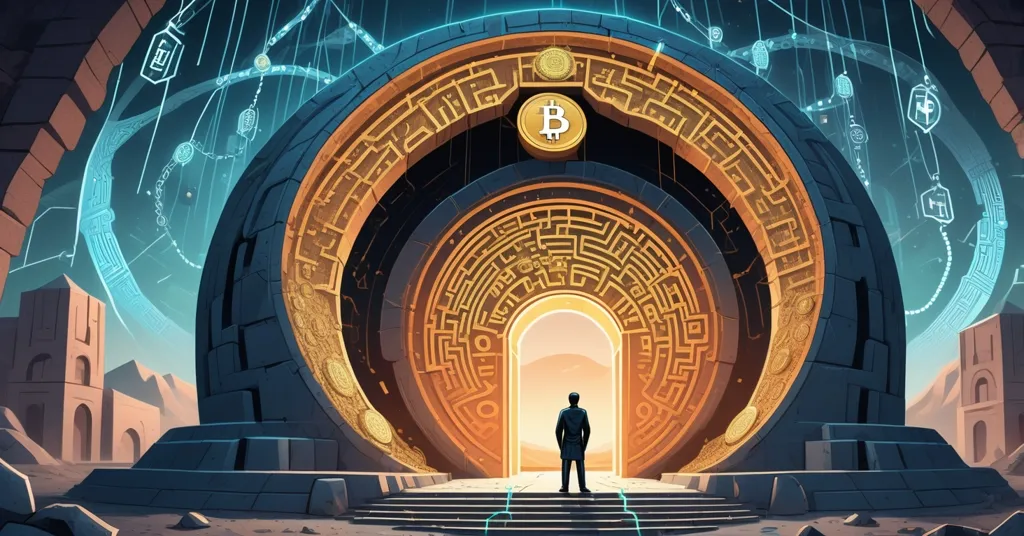Kazakhstan Pioneers National Crypto Reserve with Bitcoin and Blockchain Assets

Kazakhstan’s National Crypto Reserve: A Bold Leap into State-Owned Bitcoin and Blockchain Assets
Kazakhstan has just fired a shot across the bow of the cryptocurrency world. The National Bank of Kazakhstan (NBK) has unveiled plans to create the first-ever national crypto reserve, a state-managed fund that merges confiscated digital assets with cryptocurrencies mined under government oversight. This move thrusts Kazakhstan into uncharted territory, blending the chaotic realm of decentralized finance with the iron grip of sovereign control, potentially setting a new standard for how nations engage with blockchain technology.
- Historic First: Kazakhstan launches a national crypto reserve, a pioneering state-managed digital asset fund.
- Asset Breakdown: Combines seized cryptocurrencies from criminal busts with state-mined coins like Bitcoin.
- Safety and Oversight: Focuses on transparency, AI-driven crime detection, and strict ad regulations to combat fraud.
- Global Ripple Effect: Could inspire other countries to build similar reserves, accelerating mainstream crypto adoption.
From Mining Powerhouse to State Vault: Kazakhstan’s Crypto Evolution
Kazakhstan’s journey to a national crypto reserve is a tale of boom, bust, and strategic reinvention. By 2021, the country was a heavyweight in Bitcoin mining, commanding roughly 13% of the global hashrate—the computational power used to secure and validate transactions on the Bitcoin network. Dirt-cheap electricity, sometimes as low as $0.03 per kilowatt-hour, turned industrial backwaters into mining hubs after China’s 2021 crypto crackdown sent miners scrambling for new homes. But the party didn’t last. Energy shortages in 2021-2022 triggered blackouts, infuriating citizens and forcing the government to act. Nearly $200 million in mining gear was seized from unregulated operations, and a harsh clampdown ensued.
Fast forward to today, and Kazakhstan is flipping that chaotic history into a calculated play. The national crypto reserve will draw from two pools: cryptocurrencies confiscated from criminal activities—think busted scams or darknet markets—and coins mined through state-backed operations. With 84 licensed mining entities by 2023 and new rules mandating that 75% of mined coins be sold on registered exchanges starting in 2025, the government is tightening the reins. Energy allocation is just as ruthless: 70% of power must feed the national grid, leaving a mere 30% for mining. It’s like rationing household electricity to keep the fridge running while limiting the gaming console—harsh but pragmatic. This pivot from wild west to state-controlled vault shows a nation learning from past grid failures to carve out a strategic niche, as detailed in the Kazakhstan national crypto reserve announcement. Could this be the playbook for other resource-rich countries eyeing crypto?
Security First: Tackling Volatility and Fraud with an Iron Fist
Building a national crypto reserve isn’t just about stockpiling digital gold—it’s about keeping it safe from market mayhem and cyber crooks. NBK Chairman Timur Suleimenov is adamant about adopting international best practices, likely through a single-manager setup with audited records to ensure transparency. His goal is to shield the reserve from Bitcoin’s notorious price swings and the kind of hacks that have bled billions from private exchanges over the years, as outlined in the statement from Timur Suleimenov on June 28, 2023.
“We believe it is necessary to form a state crypto reserve based on international sovereign fund models, ensuring transparency and safety in storage and management.” – Timur Suleimenov, Chairman of the National Bank of Kazakhstan
On the enforcement front, Kazakhstan is pulling no punches. They’re deploying AI tools to sniff out suspicious transactions on unregulated crypto exchanges, having already shut down 36 such platforms in 2024 alone. This isn’t just tech for show—it’s a direct jab at money laundering and illicit trades that plague the industry, with more on these efforts covered in recent developments on crypto crime detection. Alongside this, stricter regulations on digital asset advertisements are in the works to stomp out “get rich quick” scams flooding social media. The aim is clear: protect the public from fraud while building trust in legitimate blockchain projects. It’s a gritty, no-nonsense approach, but in a space riddled with con artists, it’s hard to argue against a heavy hand.
Beyond the Reserve: A Broader Blockchain Blueprint
Kazakhstan isn’t stopping at a crypto piggy bank. This reserve is just one piece of a sprawling blockchain strategy. Take “CryptoCity,” a pilot zone designed as a sandbox for crypto transactions—think of it as a regulatory petri dish where businesses can test digital payments without the full weight of national laws. Then there’s the digital tenge, Kazakhstan’s central bank digital currency (CBDC), a government-issued digital version of its fiat currency set for a full rollout by 2025. Unlike decentralized cryptocurrencies like Bitcoin, a CBDC is tightly controlled by the state, often raising eyebrows among privacy advocates due to its potential for surveillance. Testing zones in cities like Nur-Sultan and Almaty already accept digital tenge payments, while blockchain tech is being woven into everything from uranium supply chain tracking to land record digitization. This multi-front approach, detailed in discussions on state-owned crypto asset policies, shows Kazakhstan isn’t just dipping a toe in—it’s diving headfirst into a digital future, balancing innovation with an iron grip on control.
Global Context: How Kazakhstan Stacks Up to El Salvador and the US
Zooming out, Kazakhstan isn’t operating in a bubble. Other nations are also wrestling with how to integrate crypto into state coffers, each with wildly different approaches. El Salvador made headlines by adopting Bitcoin as legal tender in 2021, a radical experiment that’s since stumbled under price volatility and lukewarm public adoption. Kazakhstan’s centralized, risk-averse model—hoarding assets rather than spending them—feels like the polar opposite. Meanwhile, proposals for a US Strategic Bitcoin Reserve and state-level funds in places like Texas echo Kazakhstan’s reserve idea, framing crypto as a hedge against inflation or sanctions. For a Central Asian nation often squeezed between Russian and Chinese influence, a crypto reserve could be a sly maneuver for financial independence, with insights on its potential impact on global Bitcoin adoption. But managing wild price dips, fending off hackers, and dodging international regulatory heat are no small hurdles. If Kazakhstan nails this, it might spark a wave of sovereign crypto funds worldwide. If it flops, it’ll be a stark warning of state overreach in a decentralized domain.
The Decentralization Dilemma: Innovation or Government Overreach?
Let’s flip the script and play devil’s advocate with a gut-check question: should we really be cheering a government hoarding Bitcoin, the very tool meant to bypass state control? As someone with a Bitcoin maximalist streak—seeing BTC as the ultimate store of value over altcoins or fiat experiments—this feels like a betrayal of Satoshi Nakamoto’s peer-to-peer vision. A national reserve risks turning a liberating tech into just another bureaucratic asset, potentially eroding the privacy and freedom that define crypto’s ethos, a concern echoed in discussions on government control over Bitcoin reserves. And what about the nuts and bolts? Crypto’s price rollercoasters could slash the reserve’s worth in a heartbeat, while state-held digital wallets are prime targets for hackers. Look at North Korea’s alleged $3 billion in stolen crypto since 2016—government treasuries aren’t bulletproof. Kazakhstan promises top-tier security, but specifics are scarce. Are they ready for a digital heist on that scale?
Then there’s the trust gap at home. After mining-induced blackouts left folks shivering through winters in 2021-2022, public skepticism runs high. Social media chatter on platforms like VK, popular in Central Asia, often paints crypto as a resource hog or elite scam. Without clear wins—say, reserve profits funding schools or roads—the government risks alienating its own people. On the flip side, as a proponent of effective accelerationism, I can’t ignore the potential kicker: state meddling, however clunky, might turbocharge crypto’s mainstream adoption, dragging even skeptics into the fold. It’s a brutal tradeoff—freedom versus scale. Where do you land on this?
Energy Woes and Public Pulse: Can Kazakhstan Sustain This Gamble?
Digging deeper, energy sustainability looms as a make-or-break factor. Mining Bitcoin guzzles power, and Kazakhstan’s grid has already buckled under the strain once before. Are there plans to avoid history’s repeat? Hints of renewable energy pilots, like solar farms near Almaty, suggest a green pivot for future mining rigs, but firm commitments are thin. If they pull off eco-conscious mining, it could quiet critics and position Kazakhstan as a model for balancing blockchain with environmental sanity, with broader context on cryptocurrencies available at Kazakhstan’s national crypto reserve background. For now, it’s a question mark hanging over the reserve’s long-term viability.
Public sentiment adds another layer of complexity. Mining’s messy legacy—blackouts and scams—has bred wariness among everyday citizens. While hard data on opinions is sparse, local economists have cautioned that without tangible economic benefits, this could be seen as another top-down scheme divorced from public need. Winning trust will demand more than slick AI tools or ad crackdowns; it’ll require showing how this reserve stabilizes the economy or creates jobs. Kazakhstan’s government has a narrow window to prove this isn’t just a shiny toy for the elite—especially in a region where financial sovereignty is often a geopolitical chess piece, as explored in NBK’s policy on transparency and security.
Key Questions on Kazakhstan’s National Crypto Reserve
- What exactly is Kazakhstan’s national crypto reserve and why is it a big deal?
It’s a state-managed fund of digital assets, primarily Bitcoin, blending confiscated cryptocurrencies from crime busts with state-mined coins, marking a global first that could redefine how nations approach blockchain as a strategic reserve. - How does this tie into Kazakhstan’s wider cryptocurrency and blockchain strategy?
It fits alongside initiatives like the digital tenge CBDC, CryptoCity testing zones for crypto payments, and blockchain use in industries like uranium tracking, reflecting a dual push for innovation and strict oversight, with further details on the strategy behind Kazakhstan’s reserve. - What’s being done to tackle crypto fraud and market volatility risks?
AI systems are monitoring shady trades on unregulated exchanges, ad regulations are tightening to curb scams, and transparent management aims to buffer against price crashes and cyber threats. - Why might Bitcoin purists and decentralization fans push back against this?
It contradicts Bitcoin’s core ethos of peer-to-peer freedom, risking privacy and autonomy by placing a revolutionary tech under state control, even if it drives broader adoption. - Could Kazakhstan’s crypto reserve reshape global blockchain policies?
Absolutely—success might nudge nations like the US or India to build their own reserves, while a flop could highlight the dangers of state-managed digital assets, shaping future approaches to sovereign crypto funds.
Kazakhstan’s national crypto reserve is a high-stakes experiment that could rewrite the rules of how governments tango with decentralized tech. It’s a tightrope act—embracing the future of finance while wrestling with its inherent chaos. For Bitcoin diehards, it’s a bitter pill: state involvement might propel adoption but at the steep cost of the very principles that birthed crypto. For pragmatists, it’s a daring step that could cement blockchain as a legitimate asset class on the world stage. All eyes are on Central Asia to see if this bet pays off or turns into a cautionary tale of overreach. One thing’s certain—Kazakhstan isn’t playing small, and the crypto space just got a hell of a lot more interesting.



